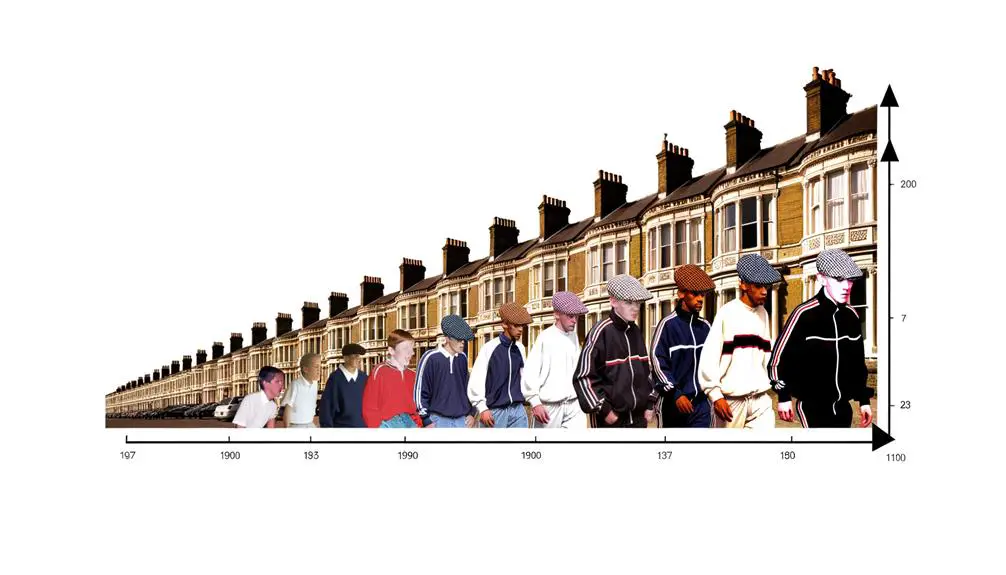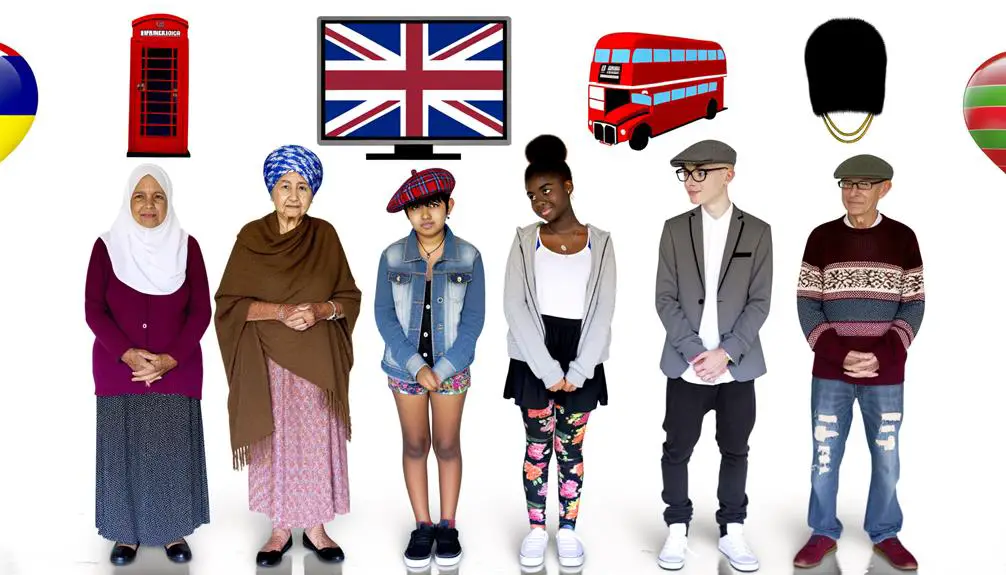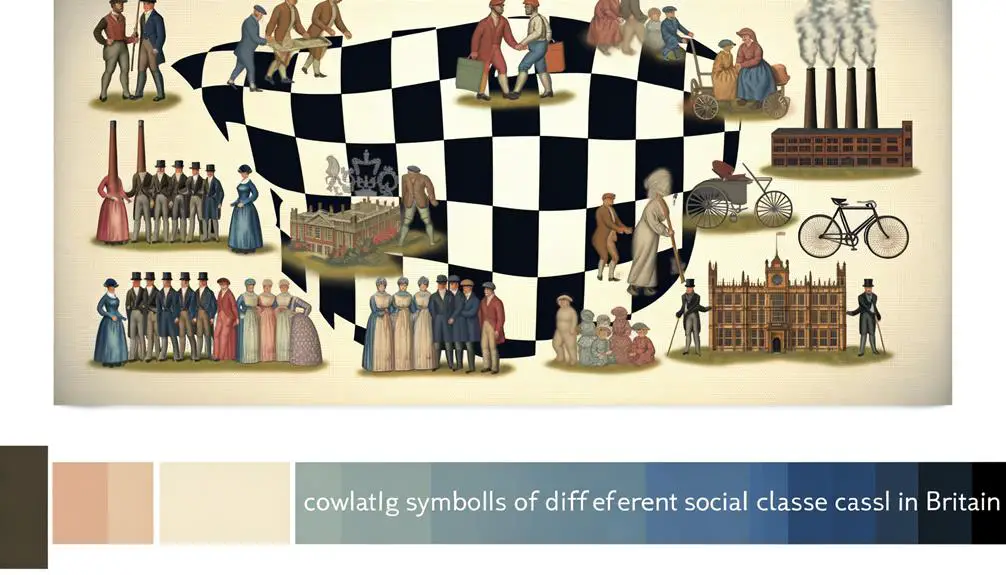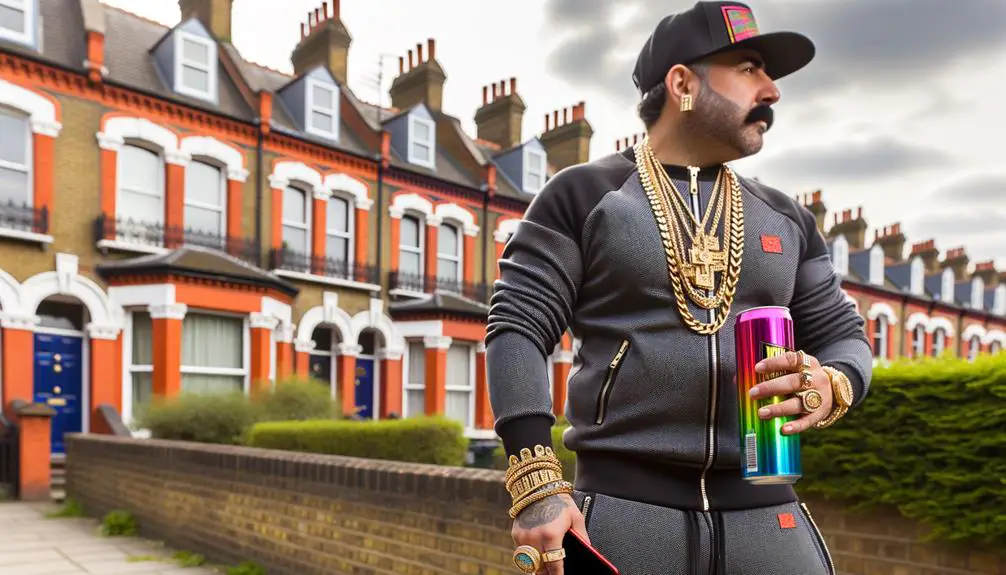In British slang, "chav" is a term that's emerged from the Romani word "chavi," which means "child." It's come to describe a stereotype associated with working-class youth, reflecting complex socio-cultural dynamics within the UK. The term's usage has evolved, shifting from regional jargon to a broadly recognized label across the nation. Your understanding of "chav" should not merely be confined to attire, which combines brand visibility with specific stylistic choices, signaling desires for social mobility and visibility. This phenomenon doesn't exist in a vacuum but is deeply embedded in class stereotypes and economic disparities that shape societal perceptions. Unpacking this concept further opens up insights into broader social and cultural discussions.
Key Takeaways
- 'Chav' is a British slang term originating from the Romani word 'chavi,' meaning 'child'.
- It describes a stereotype of working-class youth, often associated with certain fashion choices.
- The term reflects societal perceptions of social and economic class, highlighting disparities.
- Media representation has played a significant role in perpetuating the 'chav' stereotype.
- The usage of 'chav' is controversial due to its association with class discrimination and social stigma.
Origin of 'Chav'

The term 'chav' is believed to have emerged in the early 2000s, originating from the Romani word 'chavi,' which means 'child.' This etymological root suggests a connection to the Romani community, a nomadic ethnic group with origins in northern India, highlighting a linguistic exploration that reflects the complex socio-cultural interactions within the UK. However, etymology discussions around 'chav' have fueled conversations among linguists and cultural scholars, pointing to the dynamic nature of slang and its ability to encapsulate societal attitudes.
Linguistic variations of 'chav' reveal its adaptability and the nuances in its interpretation across different regions and social groups. These variations not only underscore the term's widespread usage but also its evolution within the English lexicon, reflecting changes in societal perceptions of class and identity. The academic discourse surrounding 'chav' delves into how language functions as a mirror to societal divisions, with its etymology and linguistic variations offering insights into the complexities of British social stratification. Through this lens, 'chav' becomes more than mere slang; it emerges as a linguistic artifact that captures the intricacies of social dynamics in contemporary Britain.
Definition and Usage
In contemporary British vernacular, 'chav' is often employed to describe a particular stereotype associated with working-class youth, characterized by specific fashions, behaviors, and attitudes perceived by some as indicative of low social status or poor taste. The term's linguistic transformation has seen it shift from obscure regional slang to a broadly recognized label, illustrating changes in societal attitudes and the dynamics of class perception. This evolution is not uniform, however, as regional variations in the term's connotation and usage underline the complex interplay between language, class, and identity in the UK.
| Aspect | Description | Importance |
|---|---|---|
| Linguistic Evolution | 'Chav' has evolved from regional jargon to widespread use, reflecting changing class dynamics. | Central to understanding its current meaning. |
| Regional Variations | The term's meaning and connotations can vary significantly across different parts of the UK. | Highlights the socio-cultural diversity within British society. |
| Usage | While often pejorative, usage contexts can vary from disdainful to ironically affectionate. | Indicates the term's flexibility and the complexity of attitudes it represents. |
Analyzing 'chav' within these frameworks reveals much about British social structures and the role of language in shaping and reflecting societal norms.
Fashion and Appearance

Shifting focus to the domain of fashion and appearance, one observes that 'chav' attire plays a pivotal role in the stereotype's societal perception, encapsulating a blend of brand visibility and stylistic choices that signal cultural affiliation and social identity. The prominence of certain clothing brands among those labeled as 'chav' underscores a complex narrative around consumption, identity, and class. Remarkably, brands that offer conspicuous logos and are perceived as symbols of affluence—despite their actual market positioning—frequently feature in the 'chav' wardrobe.
This choice of apparel, often rooted in the desire for social mobility and visibility, highlights a nuanced understanding of how fashion serves as a vehicle for expressing both belonging and individuality within specific cultural contexts. The style evolution witnessed within this group reflects broader trends in streetwear and youth fashion, adapting and incorporating elements that resonate with their aesthetic preferences and social aspirations.
Analyzing 'chav' fashion provides insights into how clothing functions as a marker of social identity, with brand affiliations and stylistic evolutions offering a lens through which to explore the complex interplay between personal expression and societal labels.
Social and Economic Context
You'll find that the term 'chav' is deeply rooted in class stereotypes and perceptions, reflecting broader social and economic disparities. The impact of such disparities is further magnified by media representation, which often perpetuates these stereotypes. Understanding these contexts is essential for grasping the complex connotations and usage of 'chav' within British society.
Class Stereotypes and Perceptions
Class stereotypes and perceptions deeply influence the social and economic context of the term 'chav,' reflecting broader societal attitudes towards class and socioeconomic status. This term is emblematic of the cultural evolution that has seen language adapt and shift in response to changing social dynamics. The linguistic shift encapsulating 'chav' showcases how societal discourse frames certain groups, often based on economic and social standing. It's a mirror to how class distinctions are drawn and perceived, highlighting a dichotomy between the affluent and the less privileged. This notion is not static; it evolves with society's changing views on wealth, success, and cultural capital. Consequently, 'chav' serves as a lens through which class stereotypes and perceptions are both revealed and perpetuated, underlining the complexities of social identity in contemporary Britain.
Economic Disparities Impact
Understanding the term 'chav' within the framework of economic disparities highlights how social and economic contexts greatly shape perceptions and interactions between different societal groups. This term, often pejorative, becomes entangled with discussions of income inequality and the wealth gap, serving as a lens through which the complexities of economic stratification are viewed. The label 'chav' is not just a superficial tag; it's a manifestation of underlying economic tensions. It reflects and reinforces the divide between the affluent and the less privileged, underpinning societal attitudes towards wealth and class distinction. As income inequality widens, the term's usage underscores the persistent, often stigmatized, visibility of the wealth gap, revealing deep-seated prejudices rooted in economic disparity.
Media Representation Effects
In examining the role of media representations, it's clear that such portrayals greatly influence societal perceptions and stereotypes surrounding the 'chav' identity within both social and economic contexts. Through global comparisons, we observe how different cultures interpret similar socioeconomic groups, often shaped by the media's narrative. Policy responses to these stereotypes also vary considerably, highlighting the power of media in shaping public policy and societal attitudes.
| Aspect | Impact |
|---|---|
| Global Comparisons | Highlights diverse interpretations and stereotypes |
| Policy Responses | Influences on public policy and societal attitudes |
| Economic Context | Media portrayal affects economic opportunities |
| Social Context | Strengthens stereotypes, impacting social mobility |
This table illustrates the complex interplay between media representation and its effects on both social and economic dimensions, urging a reevaluation of how societies perceive and react to the 'chav' identity.
Perceptions and Stereotypes
Stereotypes surrounding the term 'chav' reflect a complex web of social perceptions and biases, deeply entwined with the fabric of British society. This lexicon's cultural evolution has not occurred in isolation; rather, it mirrors broader global comparisons of class-based stereotypes, delineating how societies categorize and perceive their underprivileged. Through these comparisons, one observes a universal tendency to stigmatize certain socio-economic groups, yet the 'chav' phenomenon remains uniquely British, encapsulating specific attitudes towards fashion, language, and behavior perceived as indicative of lower social strata.
Understanding these stereotypes requires dissecting the layers of meaning attributed to 'chav', a term that connotes not just economic status but perceived moral and intellectual deficiencies. This conflation of economic with moral standing feeds into a broader narrative of social exclusion and stratification, highlighting the role of language in reinforcing societal divides. The term's pejorative usage underscores a discomfort with visible markers of class difference, revealing underlying tensions about mobility, aspiration, and the right to occupy public spaces.
In essence, the stereotypes associated with 'chav' offer a window into the complexities of British class dynamics, where language serves as a battleground for issues of respectability, identity, and social positioning. Through this lens, the 'chav' discourse reveals as much about the observers as it does about those observed, reflecting broader anxieties about social cohesion and the boundaries of belonging.
Media Influence

The media's portrayal of 'chav' culture has greatly shaped public perceptions, molding societal understanding of this group's identity and values. Through various forms of media, from television documentaries to news reports, the narrative surrounding 'chav' culture has often been one of fascination and, at times, derision. This portrayal has led to a nuanced dialogue, where the distinction between reality and media representation becomes blurred.
Celebrity endorsements have played a pivotal role in this scenario. When public figures associated with 'chav' aesthetics gain prominence, their visibility can either reinforce stereotypes or challenge them. These endorsements often carry a dual edge, as they can perpetuate certain perceptions while also providing a platform for broader discussions about class and identity within the UK.
Moreover, digital platforms influence the dissemination and reception of 'chav' culture significantly. Social media, particularly, has become a battleground where representations are contested and redefined. User-generated content allows for a multitude of voices to contribute to the narrative, offering perspectives that may diverge from mainstream media portrayals. This digital democratization of discourse provides a space for more nuanced understandings to emerge, challenging oversimplified or stigmatized views.
Controversies and Criticism
As you explore the controversies and criticism surrounding the term 'chav', it's important to understand how it intersects with class discrimination concerns and media representation issues. The term's usage often reflects deep-seated biases within societal structures, magnifying stereotypes linked to socio-economic status. This analysis illuminates the critical discourse on how language perpetuates inequality and shapes public perception.
Class Discrimination Concerns
Despite its widespread usage in colloquial British English, the term 'chav' has sparked significant controversy due to its underlying class discrimination, raising concerns about the societal impact of such stereotypes. You might find that the label often undermines social mobility, subtly suggesting that individuals from certain socio-economic backgrounds are incapable of transcending their circumstances. This perception hampers efforts towards achieving equality, reinforcing a cycle of prejudice and exclusion.
Policy solutions aimed at addressing this deep-rooted bias must focus on education, community support, and inclusive social policies that encourage diversity and integration. By challenging and dismantling the stereotypes associated with the term 'chav', you can contribute to a more equitable society where everyone has the opportunity to succeed, regardless of their background.
Media Representation Issues
Media's portrayal of the 'chav' stereotype has further complicated the discourse, often amplifying existing social prejudices rather than challenging them. You've likely noticed how television, films, and print media often depict 'chavs' in a manner that lacks cultural sensitivity, reinforcing negative stereotypes rather than offering a nuanced view. This not only perpetuates stigma but also overlooks the socio-economic contexts shaping these identities. The issue at hand is not just about representation but representation diversity. It's vital for media to embrace a wider spectrum of narratives that reflect the complexities of social class in Britain. By prioritizing cultural sensitivity, media can play a transformative role in how these social identities are perceived, moving beyond caricatures to foster a more inclusive and understanding society.
Impact on British Culture

The term 'chav' has greatly influenced British culture, reflecting and reinforcing class-based divisions within society. This influence is conspicuously evident in the domains of language evolution and social mobility. As you explore the linguistic landscape of the UK, you'll find that 'chav' has become emblematic of a broader discourse on class and identity. Its usage underscores the dynamic nature of language, evolving from a descriptor of a specific subculture to a term laden with judgments and assumptions about economic status, education, and taste.
Moreover, the term's impact on social mobility cannot be understated. It serves as a barrier, a verbal embodiment of the glass ceilings faced by individuals from working-class backgrounds. The label 'chav' not only stigmatizes based on superficial markers such as fashion and speech but also contributes to a self-fulfilling prophecy wherein those tagged with the label find it harder to ascend the social ladder. This linguistic marginalization perpetuates a cycle of exclusion, limiting opportunities for those it brands.
In dissecting the cultural ramifications of 'chav,' it's clear that its significance extends far beyond a mere word. It's a mirror to societal attitudes, a tool of division, and a challenge to the ideals of inclusivity and equality.







